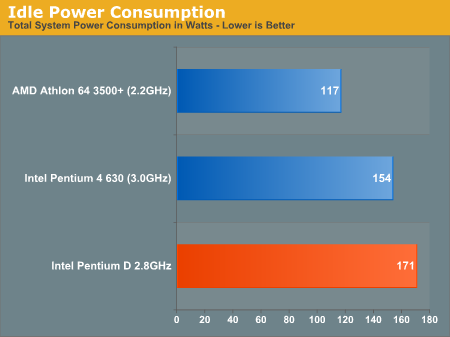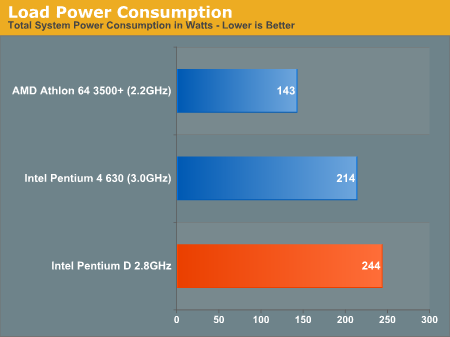Intel Dual Core Performance Preview Part II: A Deeper Look
by Anand Lal Shimpi on April 6, 2005 12:23 PM EST- Posted in
- CPUs
I'll admit, dual core has me excited for many of the reasons outlined in Part I. A big part is that personally, I've been using multiprocessor systems in my main computer for years. I've always appreciated the benefits of multiprocessor platforms, but recommending one for a desktop user has never been really feasible. Even the cheapest 2P workstation motherboards were at least twice the price of a desktop motherboard, not to mention the cost of the CPUs. The mass market had a short affair with multiprocessing in the days of the ABIT BP6 and the Celeron 300A, but in the grand scheme of things, that was barely a blip on the radar. Now, for the first time, both AMD and Intel are ready to bring the type of robustness of multiprocessor platforms to the desktop with their dual core offerings.
Part I focused on what dual core can offer, but now it's time for a much more practical look. We've never recommended Intel's Extreme Edition line of processors nor AMD's FX series, both supposedly marketed to gamers, but not purchased by any of our gaming readers. The processors that we recommend are usually much better values for the price, and thus, today's comparison isn't based around the most expensive dual core offerings, but rather the cheapest.
A point we made in the first article was that Intel's pricing strategy for dual core is extremely aggressive, with the cheapest 2.8GHz Pentium D soon to be introduced at $241. The problem is that at only 2.8GHz, the Pentium D won't have the strongest single threaded performance, which puts buyers in a sticky situation - do you buy an Athlon 64 3500+ for great single threaded performance or will the Pentium D give you a better overall multitasking experience? Intel doesn't do much to complicate the situation, as the Pentium D 2.8GHz will be close in price to the Pentium 4 630 (3.0GHz), which isn't much of a clock speed advantage. AMD will eventually have competitively priced dual core parts, but right now, AMD doesn't appear to be looking at the mainstream desktop market for dual core Athlon 64 chips.
The three chips mentioned above are the basis of the majority of today's comparison, but the decision is far from clear cut. Let's find out why.
Power Consumption
We'll start with power consumption - the contenders? A 90nm Athlon 64 3500+ vs. the Pentium 4 630 and the dual core 2.8GHz Pentium D. As always, we measured total system power at two states: idle and under a full load. For our full load test, we used a multithreaded application, 3ds max 7, performing the CBALLS2 render test from the SPECapc benchmark.


The K8 architecture simply lends itself to lower power consumptions than Intel's high frequency approach to computing with the Pentium 4 (especially Prescott). The move down to 90nm really reduced AMD's power consumption a lot, to the point where the 90nm Athlon 64 3500+ actually consumes less power under full load than the Pentium 4 630 at idle.
The Pentium 4 vs. Pentium D comparison is also interesting, as the 2nd core doesn't add all that much to overall system power consumption. In this case, we're looking at an increase in overall system power consumption by less than 15%. Intel still doesn't win in the power consumption department though; if you want something cool and quiet, AMD is still the way to go.
The Test
Our hardware configurations are similar to what we've used in previous comparisons.
AMD Athlon 64 Configuration
Socket-939 Athlon 64 CPUs
2 x 512MB OCZ PC3200 EL Dual Channel DIMMs 2-2-2-10
NVIDIA nForce4 Reference Motherboard
ATI Radeon X850 XT PCI Express
Intel Pentium 4 Configuration
LGA-775 Intel Pentium 4 and Extreme Edition CPUs
2 x 512MB Crucial DDR-II 533 Dual Channel DIMMs 3-2-2-12
Intel 955X Motherboard
ATI Radeon X850 XT PCI Express










106 Comments
View All Comments
segagenesis - Wednesday, April 6, 2005 - link
#30 - Excuse me for trying to save money also. Last I checked Intel was still more expensive. Not to mention Extremely Expensive edition.rqle - Wednesday, April 6, 2005 - link
All i know is that i alt-tab / alt-enter to the desktop running general apps all the time while gaming. I bought two system so i can download while gaming on the other system for this very reason. To do both at the same time would cause the ftp software to go into idle state with the fastest download speed at only 8-10kb/s. I can set the ftp software at a higher priority but then it would just cripple my gaming. These dual core look very promising, but ill hold out for amd dual core.GentleStream - Wednesday, April 6, 2005 - link
I'm interested in benchmarks that would be relevant to scientific computing and software development.How about benchmarking a parallel compile of some non-trivial software package such as building the
gcc compiler. That takes quite a long time on my 4 year old laptop.
danidentity - Wednesday, April 6, 2005 - link
So when are the Pentium D and the new chipsets being released?Spill it Anand. ;)
Turnip - Wednesday, April 6, 2005 - link
#23What about the fourth option? That by the time AMD's desktop dual core processor is available, Intel will have a new dual core processor available. Now, whether we're talking more than "two cores bunged on a chip", or whether we're simply talking a jacked up FSB (which has, remember, always given Intel a hefty jump in the encoding arena), I don't know. But I do know one thing...
Intel is a very big company and Intel has very big sleeves. ;)
Anand Lal Shimpi - Wednesday, April 6, 2005 - link
SpearhawkGood catch, the graphing engine didn't regenerate those graphs properly. Fixed now.
Take care,
Anand
Questar - Wednesday, April 6, 2005 - link
I love this, all the AMD fanboys having seizures over that fact that an Intel CPU can actually have some benefits.It's been a blast reading all these posts the last two days.
Spearhawk - Wednesday, April 6, 2005 - link
He said that a 2.2 GHz dualcore Athlon 64 wouldn't compete with the 2.8 GHz Pentium D at encoding. Notice the encoding part, he said nothing about other stuff.I'm guessing one can know that by looking at dual CPU Opteron systems, the dualcore A64 won't beat them, and if they can't beat a 2.8 Pentium D then the dualcore A64 won't be able to either.
Is there something wrong with the graphs in the DVD Shrink/Game test? The comments doesn't seem to match them (especialy the part about the minimum frame rate being equal)
PorBleemo - Wednesday, April 6, 2005 - link
How do you calculate the system wattages like that? I have been attempting to find detailed information on how to do this but have turned up nothing yet.Thanks!
Illissius - Wednesday, April 6, 2005 - link
#10 - you are quite correct. anyone who games with a processor-intensive background task running at the same time _on a single core processor_ is insane. the reason I wanted to see benchmarks is to see whether dual core changes that.theoretically, I don't see why it wouldn't work:
- you only have one GPU, and only the game is using it
- you have two processor intensive tasks - the game and the background task, and two cores, one for each
hence, no conflict. whether that actually holds up in the real world is/was the question (if the background task is multithreaded, or heavily uses reasources other than just the processor, then naturally the above doesn't hold true).